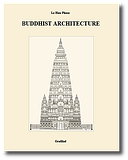Buddhist architecture
Le Huu Phuoc:
Buddhist architecture / Le Huu Phuoc. - Lakeville, MN : Grafikol, 2010. - ca. 344 S. : Ill.
ISBN 978-0-9844043-0-8
US$ 30,00
DDC: 722.44 oder 726.143
Beschreibung
The volume thoroughly examines the origins and principal types of Buddhist architecture in Asia primarily between the third century BCE-twelfth centuries CE with an emphasis on India. It aims to construct shared architectural traits and patterns alongwith the derivative relationships between Indian and Asian Buddhist monuments. It also discusses the historical antecedents in the Indus Civilization and the religious and philosophical foundations of the three schools of Buddhism and its founder, Buddha. Previously obscure topics such as Aniconic and Vajrayana (Tantric) architecture and the four holiest sites of Buddhism will also be covered in this comprehensive volume. The author further investigates the influences of Buddhist architecture upon Islamic, Christian, and Hindu architecture that have been overlooked by past scholars. [Verlagsinformation]
Inhalt
Preface. 4
PART I. BACKGROUND
1. Indus Civilization. 6
2. Foundation of Buddhism. 14
PART II. ARCHITECTURE
3. Asoka Pillar. 30
4. Monastery. 46
5. Rock-hewn Cave. 97
6. Stupa. 140
7. Temple. 233
8. Four Holiest Sites. 267
Glossary. 287
Chronology. 293
Maps. 296
Illustrations and Credits. 301
Bibliography. 302
Index. 325
Autor
The author studied architecture at the University of Minnesota and Minneapolis Technical College. He worked for several years in architecture firms as an Architectural CAD Draftsman and he is also a photographer.
Quellen: Grafikol; Amazon; Google Books
Ähnlich
- Early Buddhist Architecture in Context
- Entering the Dharmadhatu
- Buddhist Practice and Visual Culture
- Jokhang
- Sears: Worldly Gurus and Spiritual Kings
- Therigatha
- Franco/Notake: Dharmakīrti on the Duality of the Object
- Moriyama: Omniscience and Religious Authority
- Women in Early Indian Buddhism
- Buddhism and Law

